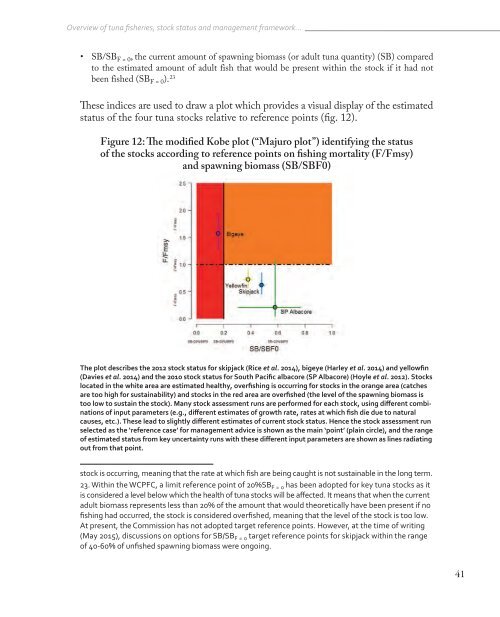Fisheries in the Pacific
Fisheries_in_the_Pacific
Fisheries_in_the_Pacific
You also want an ePaper? Increase the reach of your titles
YUMPU automatically turns print PDFs into web optimized ePapers that Google loves.
Overview of tuna fisheries, stock status and management framework…<br />
• SB/SB F = 0 , <strong>the</strong> current amount of spawn<strong>in</strong>g biomass (or adult tuna quantity) (SB) compared<br />
to <strong>the</strong> estimated amount of adult fish that would be present with<strong>in</strong> <strong>the</strong> stock if it had not<br />
been fished (SB F = 0 ). 23<br />
These <strong>in</strong>dices are used to draw a plot which provides a visual display of <strong>the</strong> estimated<br />
status of <strong>the</strong> four tuna stocks relative to reference po<strong>in</strong>ts (fig. 12).<br />
Figure 12: The modified Kobe plot (“Majuro plot”) identify<strong>in</strong>g <strong>the</strong> status<br />
of <strong>the</strong> stocks accord<strong>in</strong>g to reference po<strong>in</strong>ts on fish<strong>in</strong>g mortality (F/Fmsy)<br />
and spawn<strong>in</strong>g biomass (SB/SBF0)<br />
The plot describes <strong>the</strong> 2012 stock status for skipjack (Rice et al. 2014), bigeye (Harley et al. 2014) and yellowf<strong>in</strong><br />
(Davies et al. 2014) and <strong>the</strong> 2010 stock status for South <strong>Pacific</strong> albacore (SP Albacore) (Hoyle et al. 2012). Stocks<br />
located <strong>in</strong> <strong>the</strong> white area are estimated healthy, overfish<strong>in</strong>g is occurr<strong>in</strong>g for stocks <strong>in</strong> <strong>the</strong> orange area (catches<br />
are too high for susta<strong>in</strong>ability) and stocks <strong>in</strong> <strong>the</strong> red area are overfished (<strong>the</strong> level of <strong>the</strong> spawn<strong>in</strong>g biomass is<br />
too low to susta<strong>in</strong> <strong>the</strong> stock). Many stock assessment runs are performed for each stock, us<strong>in</strong>g different comb<strong>in</strong>ations<br />
of <strong>in</strong>put parameters (e.g., different estimates of growth rate, rates at which fish die due to natural<br />
causes, etc.). These lead to slightly different estimates of current stock status. Hence <strong>the</strong> stock assessment run<br />
selected as <strong>the</strong> ‘reference case’ for management advice is shown as <strong>the</strong> ma<strong>in</strong> ‘po<strong>in</strong>t’ (pla<strong>in</strong> circle), and <strong>the</strong> range<br />
of estimated status from key uncerta<strong>in</strong>ty runs with <strong>the</strong>se different <strong>in</strong>put parameters are shown as l<strong>in</strong>es radiat<strong>in</strong>g<br />
out from that po<strong>in</strong>t.<br />
stock is occurr<strong>in</strong>g, mean<strong>in</strong>g that <strong>the</strong> rate at which fish are be<strong>in</strong>g caught is not susta<strong>in</strong>able <strong>in</strong> <strong>the</strong> long term.<br />
23. With<strong>in</strong> <strong>the</strong> WCPFC, a limit reference po<strong>in</strong>t of 20%SB F=0 has been adopted for key tuna stocks as it<br />
is considered a level below which <strong>the</strong> health of tuna stocks will be affected. It means that when <strong>the</strong> current<br />
adult biomass represents less than 20% of <strong>the</strong> amount that would <strong>the</strong>oretically have been present if no<br />
fish<strong>in</strong>g had occurred, <strong>the</strong> stock is considered overfished, mean<strong>in</strong>g that <strong>the</strong> level of <strong>the</strong> stock is too low.<br />
At present, <strong>the</strong> Commission has not adopted target reference po<strong>in</strong>ts. However, at <strong>the</strong> time of writ<strong>in</strong>g<br />
(May 2015), discussions on options for SB/SB F=0 target reference po<strong>in</strong>ts for skipjack with<strong>in</strong> <strong>the</strong> range<br />
of 40-60% of unfished spawn<strong>in</strong>g biomass were ongo<strong>in</strong>g.<br />
41


